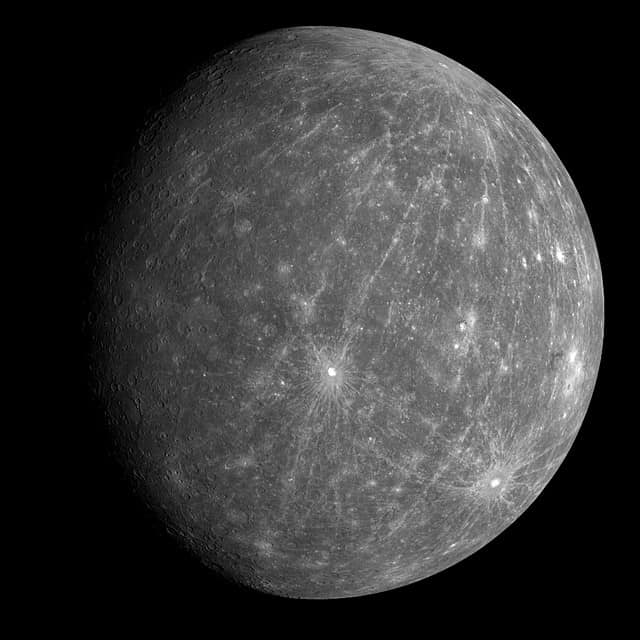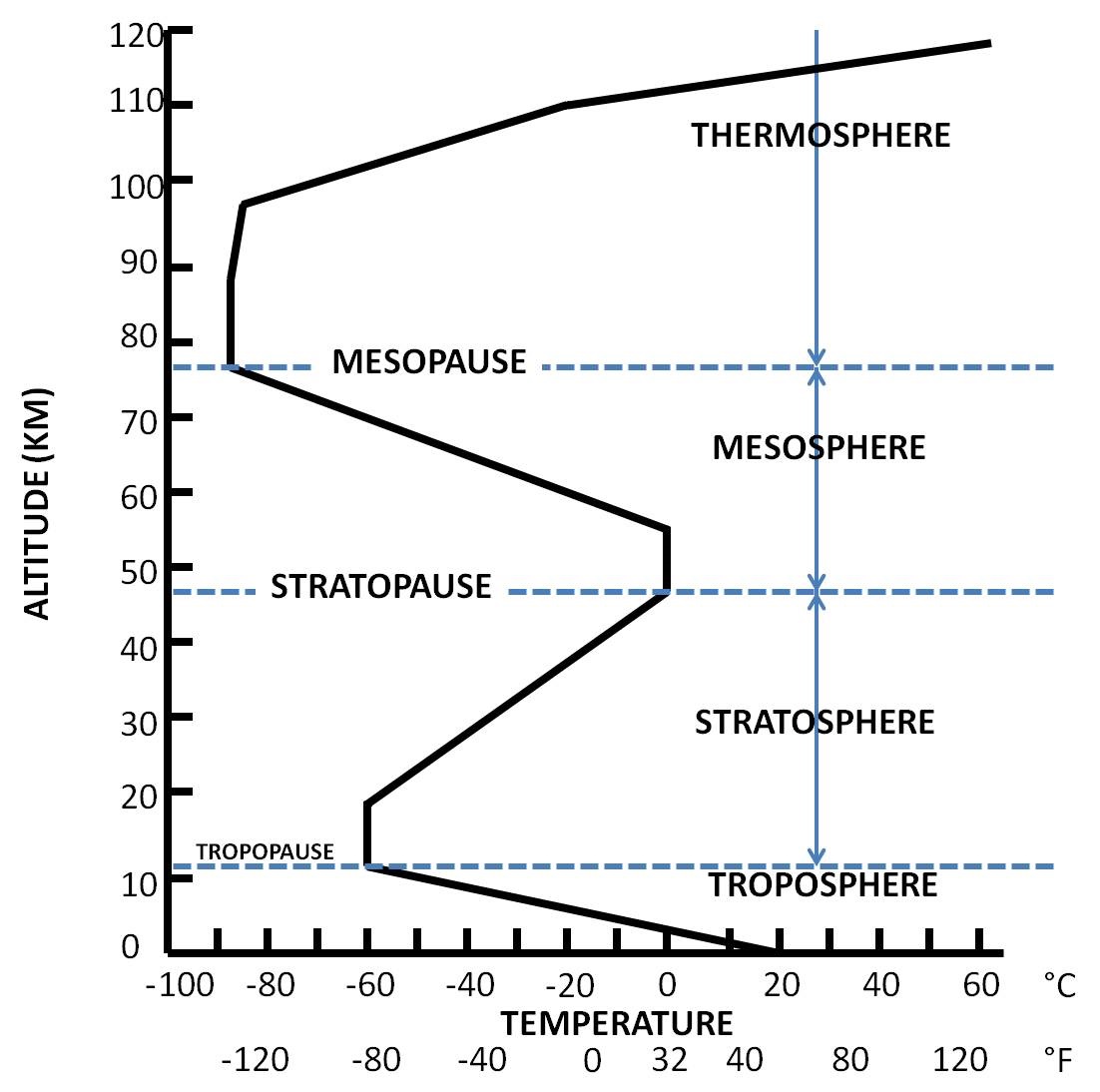The solar system is a group of planets that orbit the Sun. The weather on each planet depends on its distance from the sun and the movement of the gasses in the atmosphere of each planet.
The Earth’s atmosphere is divided into layers according to temperature and stability. The Earth is the only planet in our solar system which atmosphere consists of large amounts of water and water vapor. It is the only atmosphere that can sustain life as we know it.
Not all planets have atmospheres and no other plant in or solar system can sustain life like our earth. Below is a discussion on each planet’s atmosphere and any associated weather. We also give a more complete analysis of the earth’s atmosphere, composition and its layers.
If you would like to see what you know about the atmosphere, take the quiz below.
Atmosphere Practice Test
Most weather takes place in the troposphere, but the other layers of the atmosphere can give valuable information on changing conditions.

The Sun’s Atmosphere And Its Effect On The Earth’s Atmosphere
The sun does have its own atmosphere, but it is not classified as a planet. It is classified as a star due to it make up of gases.
Atmospheric Composition Of The Sun
| Element | Abundance (pct. of total number of atoms) | Abundance (pct. of total mass) |
|---|---|---|
| Hydrogen | 91.2 | 71.0 |
| Helium | 8.7 | 27.1 |
| Oxygen | 0.078 | 0.97 |
| Carbon | 0.043 | 0.40 |
The Sun sends out rays of heat and light called radiation. The suns radiation are high energy rays of different strengths. Some of these rays give us light and all of the rays heat up anything that absorb them.

What Happens To Incoming Solar Radiation From The Sun
This is energy from the Sun. It is also called short-wave radiation because the Sun is hotter than the earth and emits shorter wavelengths of radiation. These fall mainly in the ultraviolet and visible portions of the electromagnetic spectrum.
The scattering of the sun’s rays through the earth’s atmosphere is what causes the sky to appear blue.
Radiation traveling through the atmosphere is effected by the earth’s atmosphere it travels through depending on several factors including scattering, absorption, reflection and the sun’s angle. Due to scattering and absorption by atmospheric constituents, the further the energy travels through the atmosphere, the more attenuation that takes place.
What The Atmosphere & Weather Are Like On Mercury
Mercury hardly has an atmosphere, containing hydrogen, helium, oxygen, sodium, calcium, potassium, and water vapor. Solar light pushes the atmospheric gases away from the Sun, creating a comet-like tail behind the planet.

What The Weather Is Like On Mercury
Since Mercury is so close to the Sun the surface temperatures can reach over 800 degrees Fahrenheit during the day and drop as low as -279 degrees Fahrenheit at night. Due to its lack of atmosphere, Mercury does not have the type of weather as Earth. There are no clouds, wind or rain. Since Mercury has hardly any atmosphere, it does not have weather like clouds, winds rain or snow.
The Very Dense Atmosphere On Venus
The atmosphere on Venus is very dense with pressures more then 90 times that on earth and composed of carbon dioxide which is great for trapping heat from the sun’s radiation. The temperature can reach well over 800 degrees Fahrenheit. Due to the thick atmosphere, the heat from the sun is slowly absorbed and the heat that has been absorbed by the atmosphere does not escape very quickly causing the surface temperature to remain fairly steady.

What The Is Weather Like On Venus
The high surface pressure from dense atmosphere causes winds to blow at speeds of over 240 mph. The clouds on Venus are composed mostly of sulfuric acid droplets. These droplets do sometimes fall as rain, but evaporate before they reach the surface. There are also continuous lightning storms.
Atmosphere Composition Of Venus
- 96% Carbon dioxide
- 3.5 % Nitrogen
- Carbon monoxide, argon, sulfur dioxide
- <1% water vapor
Venus takes 243 Earth days to make one rotation.
Earth’s Atmosphere
The Earth’s atmosphere is divided into layers according to temperature and stability. The Earth is the only planet in our solar system which atmosphere consists of large amounts of water and water vapor.

The Moon Has No Atmosphere
The Moon is not a planet, but a satellite of the Earth. The Moon has no atmosphere due to the weak gravity that cannot hold gases to the surface.
The surface of the Moon is covered with dust.
The Thin Atmosphere On Mars
The atmosphere on Mars is very thin with very low pressure, but still thick enough to support weather, clouds and winds. It consist of mainly carbon dioxide with some nitrogen. Though there are areas of ice at the north and south poles, there is no water on Mars.

What Is The Weather Like On Mars?
Temperatures on Mars are very low due to its distance from the Sun. Daytime temperatures are usually around -20 degrees Fahrenheit and falling to around -121 degrees at night.
The surface winds are normally 10-20 mph and have been measured at 70 mph during dust storms. The atmosphere looks red from the surface due to these winds blowing the red colored sand and rocks at the surface around the thin atmosphere.
Atmosphere Composition Of Mars
- Carbon dioxide: 95.32 percent
- Nitrogen: 2.7 percent
- Argon: 1.6 percent
- Oxygen: 0.13 percent
- Carbon monoxide: 0.08 percent
- Also, minor amounts of: water, nitrogen oxide, neon, hydrogen-deuterium-oxygen, krypton and xenon
Mars has two moons that resemble asteroids more than they do moons. They are called, Phobos & Deimos.
The Fastest Atmosphere Belongs To Jupiter
The largest planet in the solar system is also the fastest rotating planet. Rotating at 22,000 mph, compared to Earth that is 1,000 mph. Jupiter has a very dense and relatively dry atmosphere a few hundred miles thick that is composed of hydrogen, helium, and small amounts of methane and ammonia.

What The Weather Is Like On Jupiter
Temperatures of the planet are very low, not rising above -200 degrees Fahrenheit. The great red spot on the planet is believed to be a massive storm which rotates counter clockwise and is four times larger than earth.
Due to the high density and the large amount of pressure and compression which causes heat, the rocky core lies well below the surface and is very hot at 36,000 degrees Fahrenheit. The planet itself is composed of almost entirely liquid hydrogen.
The fast rotation flattens the planet at the poles and drives the weather patterns in the clouds which cover the planet. The planet is tilted on its axis at only 3 degrees which causes a very minimal change in weather conditions.
The wind is driven by its internal heat and reach speeds of more than 400 mph with the presence of lightning.
The Earth’s Atmosphere Explained
Why is it important?
The earth’s atmosphere provides us with the gases and water that sustain life. It serves as a shield to protect the earth from debris in space and blocks out harmful radiation. The greenhouse effect helps keep us cool during the day and warm at night. Without the atmosphere, there would be bitterly cold nights and scorching hot days.
The earth’s atmosphere has been tested and studied for a long time and it is often discussed if it can be duplicated on another planet to sustain life. I am not that scientist and I think most of us can agree that every meteorologist on the planet is nit that scientist. If you want to check their credentials, just look at their latest weather forecast and tell me if it was flawless.
There are other that claim that manipulation of the weather is possible. I believe the farthest we can really go with that is cloud seeding and dissipation only on the micro scale. These topics are not up for discussion here and I have no intention on turning on comment to distract us from the facts.

The atmosphere can be broken into different layers based primarily on temperature characteristics. There are transitional pauses between the layers where the temperature does not increase or decrease with height.
Atmospheric Composition Of The Earth
The composition of the atmosphere is not constant; it varies from time to time and place to place. Two elements make up 99% of the volume of clean,dry air. Most of the remaining 1% is accounted for by an inert gas called argon.
| Water Vapor | Nitrogen | Oxygen | Argon |
|---|---|---|---|
| 0% | 78.084% | 20.947% | 0.934% |
| 1% | 77.30% | 20.70% | 0.92% |
| 2% | 76.52% | 20.53% | 0.91% |
| 3% | 75.74% | 20.32% | 0.90% |
| 4% | 74.96% | 20.11% | 0.89% |
| Gas | Symbol | Content |
|---|---|---|
| The Top Four Elements | = | 99.998% of the Atmosphere |
| Nitrogen | N2 | 78.084% |
| Oxygen | O2 | 20.947% |
| Argon | Ar | 0.934% |
| Carbon dioxide | CO2 | 0.035% |
| Neon | Ne | 18.182 parts per million |
| Helium | He | 5.24 parts per million |
| Methane | CH4 | 1.70 parts per million |
| Krypton | Kr | 1.14 parts per million |
| Hydrogen | H2 | 0.53 parts per million |
| Nitrous oxide | N2O | 0.31 parts per million |
| Carbon monoxide | CO | 0.10 parts per million |
| Xenon | Xe | 0.09 parts per million |
| Ozone | O3 | 0.07 parts per million |
| Nitrogen dioxide | NO2 | 0.02 parts per million |
| Iodine | I2 | 0.01 parts per million |
| Ammonia | NH3 | trace |
Water vapor is one of the most variable gases in the atmosphere. In the tropics it may account for up to 4%, by volume, of the atmosphere, while in the air in deserts and polar regions, it may comprise but a tiny fraction of 1%.
Layers Of The Earth’s Atmosphere
There are technically nine layers of the earth’s atmosphere counting the two extreme outer layers. There are only two that have enough moisture for clouds can form in. The lowest level of the atmosphere (the one we live in) is where most of the weather occurs. Only a few clouds can form in the transition layer above, however, there is no weather in this layer.
The lower layer of the earth’s atmosphere is naturally unstable with the temperature decreasing with height. Colder air is more dense and wants to sink as warm air is less dense and want to rise.
Troposphere
This is the layer of the atmosphere we live in. ALL weather takes place in this layer (lowest 11 km). The temperature decreases with height (Positive Lapse Rate) at an average rate of 6.5 ºC per 1000 meters with the temperature at the top of the layer near -50 ºC and is capped by the tropopause. This decrease in temperature with height causes an unstable environment since cold air is more dense than the warm air and will sink to the surface while the warmer air will rise.
The troposphere contains 80% of the atmosphere’s mass and almost all of the water vapor, clouds and precipitation in the atmosphere.
Strong vertical mixing occurs in the troposphere, which may be caused by mechanical turbulence (mixing due to frictional effects of the surface of the earth). Air molecules travel through the depth of the troposphere in a few days (in thunderstorms it occurs over a few minutes). Particles remain in the troposphere for only a few days to a week due to rapid mixing and precipitation. The troposphere’s heat source is the absorption of terrestrial radiation by water vapor and carbon dioxide (Greenhouse effect) and the transfer of latent and sensible heat from the earth’s surface.

Tropopause
It is the transition from the troposphere to the stratosphere and is marked by a sharp decrease in the amount of water vapor and a rapid increase in the amount of ozone (O³). The tropopause ranges from 10 to 20 km (6-12 miles) above the surface.
Stratosphere
Is called a “stable layer” because the temperature increases with height, This is called a Temperature inversion. The increase with height causes this layer of the atmosphere to remain stable, therefore, there are no clouds or weather in this layer. The temperature is highest at the top of the layer at about 0 ºC (32 ºF).
The heating of this layer is caused by the absorption of ultraviolet radiation from the sun. This is known as the Ozone layer.
The stratosphere extends from 20 km to 47 km (12-20 miles) and is extremely stable. The lapse rate through the stratosphere shows an inversion, with very little mixing occurring between the stratosphere and the troposphere. Strong thunderstorms can penetrate only a few km into the stratosphere (overshooting tops) with mixing being suppressed because of the stability. Particles can remain in the stratosphere on the order of years. Debris from past nuclear explosions and dust from volcanic eruptions are present in much higher concentrations than in the troposphere. The highest concentration of stratospheric ozone is seen between 20 and 25 km (12-15 miles). The stratosphere’s heat source is the absorption of solar radiation by ozone. The stratosphere accounts for approximately 20% of the atmospheric mass. The troposphere and stratosphere combined account for 99.9% of the atmosphere’s mass with the top of the stratosphere near the 1-mb level.
Stratopause
The stratopause is the transition from the stratosphere to the mesosphere 47 km to 55 km (29-34 miles).
Mesosphere
This is the coldest layer of all with the average temperature of about -90 ºF.
The air at this level is too thin to breathe due to the lack of oxygen. The temperature in this layer decreases with height and although there is no weather in this layer, there are a few very thin clouds.
Mesosphere means “middle sphere” and extends from 55 km to 78 km (34-48 miles). The top of the mesosphere is near 0.01 mb. Accounts for 0.099% (approximately 1/10%) of the atmosphere’s mass. Temperature decreases with height (positive lapse rate) with a temperature at the top around -100 ºC (-148 ºF) Vertical motions are not suppressed.
Mesopause
The mesopause is the transition from mesosphere to the thermosphere (78 km to 98 km).
Thermosphere
This is the warmest layer as all O2 molecules absorb a lot of solar energy. The temperature at the top of this layer is around 2000 ºC (3632 ºF) decreasing as you descend.
There are so few molecules in this layer that they can travel as far as 1 km before hitting each other! (compared to a millionth of a centimeter near the surface).
This layer extends from 98 to 500 km (60-30 miles). Temperatures increase with height (negative lapse rate). 0 to 2000°K and are directly proportional to the amount of solar activity. Temperatures range from 500
The heat source is the absorption of solar radiation by molecular oxygen (O2). The ionosphere is an electrified region within the thermosphere where there is a fairly large concentration of ions. This region is important for radio communications.
The top of this layer is called the “exosphere” – here is where the molecules can escape to space and it contains very little gases. The top of this layer is around 900 km (560 miles) from the ground. Some polar orbiting weather satellites are found in this layer.
The Magnetosphere is the uppermost layer. There are no gases in this layer. It forma a barrier that stops many particles from space entering the Earth’s atmosphere. Most satellites are located well above this layer.
Test Your Knowledge
Atmosphere Practice Test
Most weather takes place in the troposphere, but the other layers of the atmosphere can give valuable information on changing conditions.

Recent Posts
Determining Severe Weather Based On Stability Indexes and Upper-Level Winds
There are several weather products used to determine the possibility of severe weather for an area. The most common and misunderstood by many weather enthusiasts is the Skew-T chart and the upper-air...
Tornado Basics, Severe Weather Preparation, & The Enhanced Fujita scale
Earth's weather can produce various kinds of windstorms which include waterspouts, dust devils and tornadoes. Although they have the common features of a column of rotating air, they are actually...

